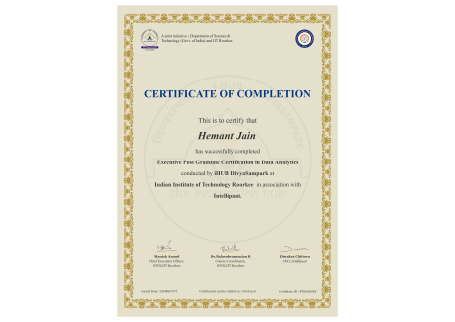Your cart is currently empty.
- Placement Assistance
- Mock Interview Preparation
- Career-Oriented Sessions
- Exclusive access to the Intellipaat Job portal
- 1-on-1 Career Mentoring Sessions
- Resume & LinkedIn Profile Building

59% Average Salary Hike
$1,08,000 Highest Salary
700+ Career Transitions
300+ Hiring Partners
Career Transition Handbook
This 12-month program helps you gain real-world exposure through hands-on projects, exercises, and case studies, and develop expertise in tools and techniques like Python, SQL, statistics, and machine learning, all guided through interactive self learning modules by Dolan School of Business faculty.
These certificates show you know how to turn data into real business outcomes.

This hands-on course equips you with statistical tools to analyze and communicate data for business decision-making. It uses spreadsheet software and case studies from finance, marketing, operations, and more.
An introduction to Python focused on general programming concepts and practical use in business analytics. You’ll work through lessons, quizzes, and coding challenges to build confidence.
This course builds both your leadership mindset and your technical fluency. It’s designed to help you think like an analytics leader while developing hands-on modeling and problem-solving abilities.
Designed for learners familiar with Python, this course dives into the essential phase of cleaning, transforming, and preparing data for analysis. It’s practical, project-oriented, and job-market relevant.
This course teaches how to manage, store, and visualize business data at scale. You’ll work with SQL, data models, and tools like Tableau to deliver insights that can drive action.
This course simulates real-world consulting. You’ll learn how to apply analytics thinking in business contexts, engage clients, and present strategic recommendations backed by data.
This course focuses on modeling uncertainty in business decisions. You’ll work with time series data, forecasting techniques, and risk simulations to make strategic predictions.
With data everywhere, knowing how to interpret and communicate insights is critical. This course helps you master modern BI tools while sharpening your data storytelling skills.
This course explores how analytics is transforming sports—from team performance to fan engagement. You’ll learn how to ask the right questions, work with real-world data, and communicate insights even to non-technical audiences.
AI doesn’t have to be intimidating. This course focuses on how to use modern, low-code tools to solve real business problems with artificial intelligence—without needing to build models from scratch.
Python Programming
R Programming
SQL for Data Analysis
Advanced Excel
Data Visualization
Dashboarding
Business Intelligence
Statistical Analysis
EDA
Machine Learning Basics
AI Fundamentals
Predictive Modelling
Mathematical Modelling
Data Cleaning
Data Storytelling
Relational Database Design
Decision Making
Process Mining
Automation Concepts
Model Deployment
Industry Problem Solving
Capstone Execution
Cloud Exposure (optional)
Case Studies & Industry Projects
Our online program attracts a wide range of professionals, making each cohort a vibrant mix of experience and industry insights.
The application process is straightforward and designed to help us understand your goals, background, and readiness for this program. Here’s how it works:
Yes, Fairfield’s MS in Business Analytics is structured for beginners, with integrated prep in Python and statistics to build a strong foundation. It delivers industry-relevant skills and strategic business insight, preparing learners for high-impact roles in analytics.
You do not need prior programming knowledge to start Fairfield’s MS in Business Analytics. The program includes preparatory work in Python and statistics, ensuring all students, regardless of background, are equipped to succeed.
Fairfield’s MS in Business Analytics stands out with its AACSB-accredited curriculum, beginner-friendly design, and real-world capstone projects guided by industry-informed faculty. Unlike many generic programs, it combines technical training in tools like Python, R, and Tableau with leadership coaching and strategic business application, making graduates job-ready for high-growth analytics roles.
The Fairfield MS in Business Analytics is primarily focused on business analytics, with a strong foundation in data tools like Python and R applied specifically to solving business problems. While you will learn core programming and statistical techniques, the emphasis is on using analytics to drive decision-making, strategy, and measurable impact in areas like finance, marketing, healthcare, and operations. AI concepts are introduced where relevant, but always in a business context, not as a standalone technical track.

